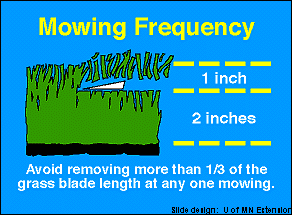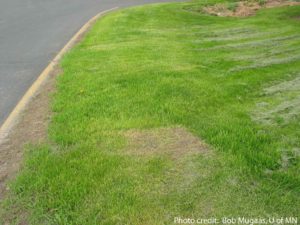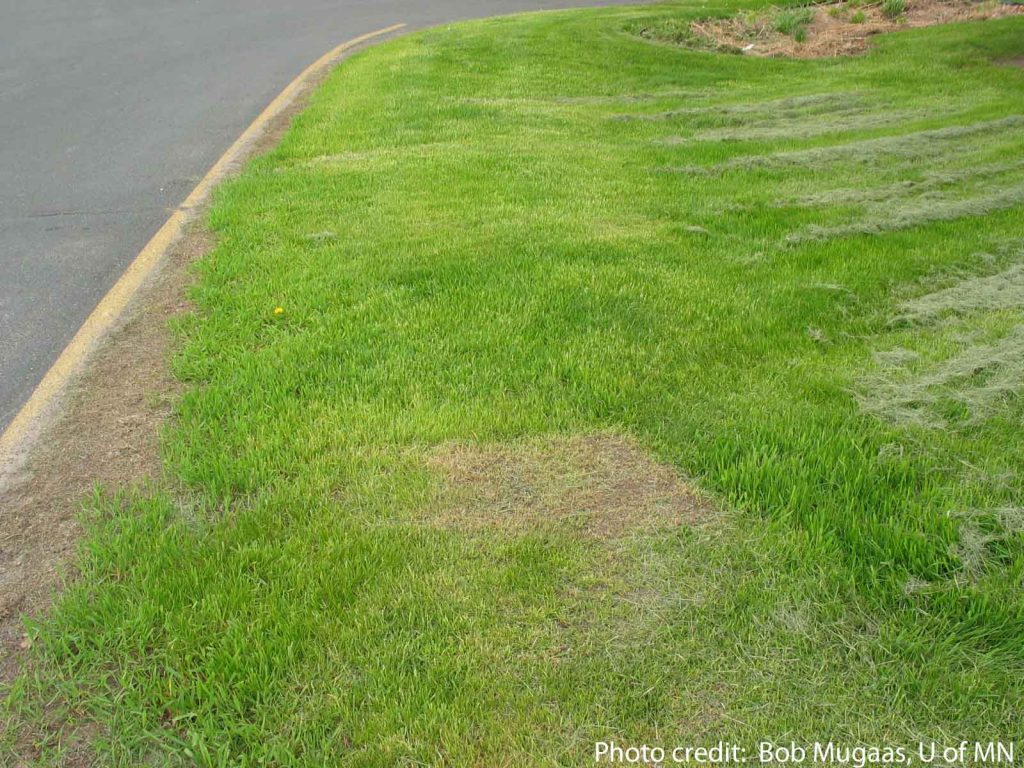From the University of Minnesota Sustainable Urban Landscape Information Series
Summer heat can take a toll on your lawn. If you mow too low, water too much or too little, or ignore early signs of pests, your grass could quickly become lackluster or even completely die in small or large patches. The general rule of thumb for mowing grass is to mow high, mow as frequently as needed, and allow the clippings to return to the lawn. Follow these mowing guidelines from the University of Minnesota for a lush, green lawn all summer long.
Mowing Height

Height of cut plays a very important role in determining the maintenance needs of a lawn. Generally, the higher the height of cut the less the maintenance required. This is primarily due to the fact that higher heights of cut promote deeper root growth into the soil.
Shorter heights of cut promote shallower root systems. Deep root systems have naturally greater access to soil water and nutrient reserves thereby increasing their ability to tolerate environmental stresses. Shallower root systems require greater attention to supplementing soil water and nutrient needs to keep the plants healthy and minimize negative effects of adverse environmental stress.
In addition to larger and deeper root systems, higher heights of cut restrict the amount of light reaching the soil surface. Since many lawn weed seeds require light for germination, the increased shading from a higher height of cut will actually suppress weed germination and growth thereby cutting down the need for herbicide use or other weed control measures. This can be particularly helpful in controlling warm season annual grasses such as crabgrass. In turn, this can reduce the dependence on pre-emergent herbicides for their control. For most lawn areas, mowing at a height of 2.5 – 3.0 inches will provide a good quality turf.
Mowing Frequency
Mowing frequency is based entirely on the growth rate of the grass. In spring and fall when grass is growing more vigorously, mowing should be more frequent than during mid-summer when growth rates slow.

Mowing frequency is also increased with shorter heights of cut. For example, if the lawn is maintained at 1 inch, then only 1/2 inch of growth is needed before mowing is required assuming that no more than 1/3 of the top growth is removed at each mowing.
On the other hand, if the height is maintained at 2.5 inches, then about 1 inch of growth could occur before mowing would be required. In general, the more growth allowed (following the 1/3 guideline) before mowing is required, the longer the time interval between mowing.
Mowing too infrequently damages the lawn by removing too much of the plant at once. A substantial amount of leaf tissue is removed with infrequent mowing, while proper mowing removes a much smaller portion of leaf tissue. Cutting too short will expose the lower portions of grass stems which are yellowish in color due to less chlorophyll present compared to the greener leaf blades above. Grass plants will now need to use food reserves to remake the necessary chlorophyll before normal growth can resume. This is an unnecessary use of food reserves and further weakens the plants ability to withstand and recover from other weather and environmental stresses.

Continually scalping the turf can seriously stress and weaken the grass plants inviting unwanted weed invasion and competition.
While most walk-behind rotary mowers adjust mowing heights by resetting the four wheels to the desired height, it is a good idea to occasionally see how close that setting really is to the actual height of cut. To do this, take a ruler and gently push it through the turfgrass canopy until it rests firmly on the lawn/ground surface. Then look across the grass plants just in front of the ruler and see what the height is. For example, if the ground is firm then mower wheels will ride higher and consequently the height setting will more closely approximate the actual cutting height. However, where the ground is soft or there is a significant thatch layer present, the wheels will sink more deeply into the lawn surface and hence, the mowing height is actually less than the wheel settings would indicate. Where there is significant thatch present, mower wheels can ride much lower than the lawn surface between the wheels resulting in scalping.
Remember to take the time to adjust your mower correctly, periodically verify that the mower height settings are actually providing the desired height of cut.
Other Factors to Keep in Mind
Following are some additional mowing tips to help keep the lawn healthy and actively growing.
- Increasing the mowing heights by an inch during mid-summer will improve the lawn’s ability to tolerate stress caused by heat and drying winds.
- Continue to mow throughout the fall until growth stops. The weather is usually warm enough for continued grass growth until late October in the Twin Cities area.
- Excessively tall grass in fall frequently mats down during winter, making it more susceptible to winter disease problems such as snow mold and invasion by meadow voles (mice-like creatures that create serpentine paths in the lawn surface and are covered by loose grass clippings; they become visible as snow melts from the lawn in the spring).
- Change the direction of mowing frequently to promote upright shoot growth. If possible, mow at right angles every other time. For example, alternating mowing patterns will prevent continuous scalping and soil compaction.
The experts at Parkway Lawn Services are ready to help you with all your MN lawn care needs, questions, and concerns. Our Minneapolis Lawn Service is bar none. Get a free estimate today!

